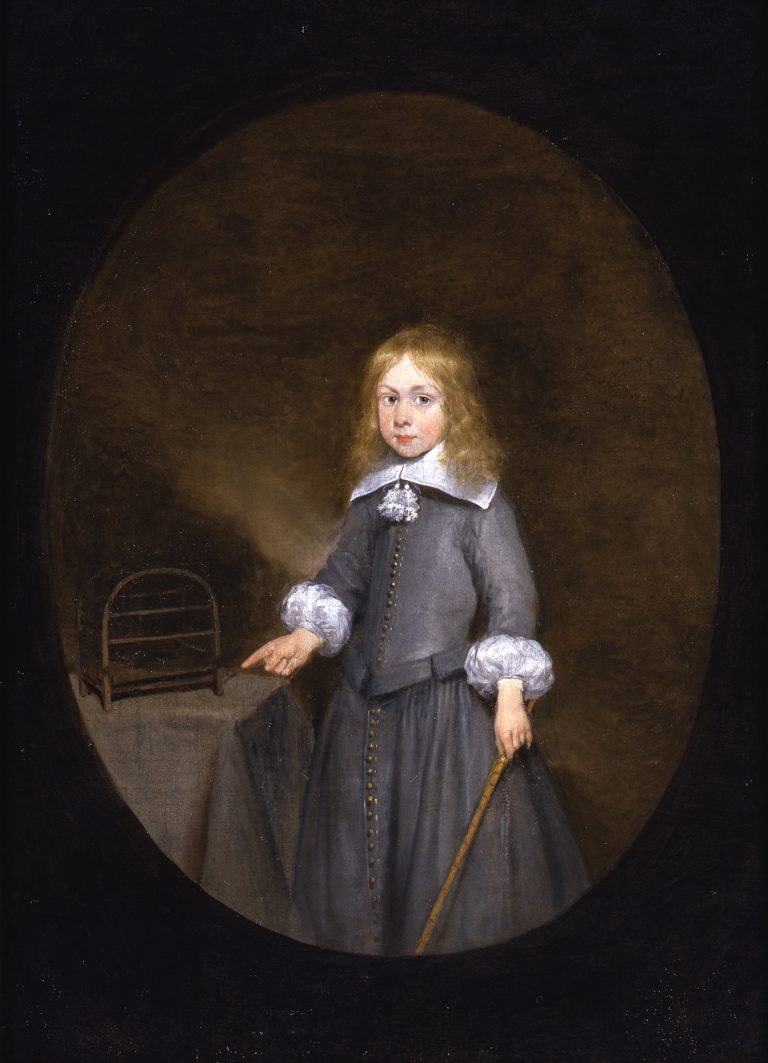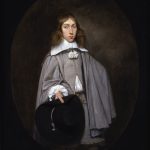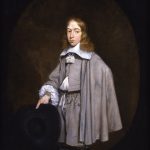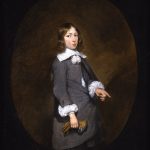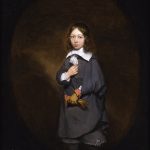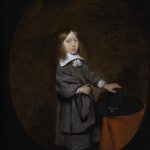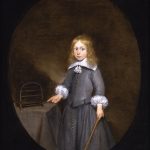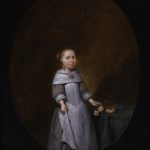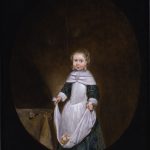This entry is about the children of the Craeyvanger family. Click here to read about their parents, Willem Craeyvanger (1615/1616–after 1666) and Christine van der Wart (1620–1666).
The portraits of the Craeyvanger family of Arnhem were practically unknown when they appeared at a sale in Amsterdam in May 2009.1 The 10 portraits caused an immediate stir, not only because it is unusual for such a group to survive, but also because of their exceptionally high quality, particularly the likenesses of the four oldest children by Gerard ter Borch (1617–1681). The series of eight children’s portraits were offered for sale in two separate lots, the four oldest children as autograph works by Ter Borch, the four youngest as by “Gerard ter Borch and studio.”2 The portraits of the four oldest children betray the hand of a more experienced master, evident in the more subtle execution of the faces, hands, and clothing, and the more convincing spatial rendering of the figures.
After the sale, the portraits of the four youngest children were attributed specifically to Ter Borch’s pupil Caspar Netscher (ca. 1639–1684), who had also painted the portrait of their mother, Christine van der Wart, in ca. 1655–56 (see CN-110.e). Netscher’s barely visible signature, which was applied in light beige paint, was found not only on the portrait of their mother, but also on the portraits of the three youngest children.3 The portrait of Gerrit, the youngest son, is the only one of the children’s portraits that bears a date, 1658. No inscription is visible on the portrait of Peter, the second youngest son, but there are remnants of a number or letter, applied in the same light-colored paint as are Netscher’s other inscriptions.4 This portrait, too, can be assigned to Netscher on the basis of its execution, which is very close to that of the other Netschers. Annotations with the names of the children portrayed and the date 1658—possibly applied in the eighteenth century—are still legible on the back of the eight unlined paintings. There is no other known example in seventeenth-century Dutch painting of such an extensive series of portraits of the members of one family, in which the individual portraits of the children (here, eight) form an entity.5
The children’s portraits were painted in the elegant, small-figure style of portraiture that was Ter Borch’s trademark. They were conceived as a group of pendants, with each pair of sitters inclined toward each other; in the left-hand portraits the light falls from the upper left, and in the right-hand portraits from the upper right. The unity of style that characterizes these portraits makes clear that they originated in close collaboration between Ter Borch and Netscher, who are known to have shared painting materials.
The children are portrayed three-quarter length, standing in front of a grayish background on which they cast shadows. The dark oval borders around the portraits, which were painted rapidly with broad brushstrokes, function like trompe l’oeil frames that seem to cast a narrow band of shadow along the edges of the ovals.6 These borders were not originally covered by the oval inlays of the lost frames, as evidenced by the lack of minimal damage to the paint surface that one would then expect to find in these areas, and by the fact that the craquelure covers the entire surface of the rectangular canvases evenly.7
The two oldest boys—Jan and Willem, 17 and 15 years old, respectively—are nearly grown up.8 Both of these self-assured youths are shown resting a hand on a hip below a light gray cape and demonstratively holding a hat in the other hand. Their somewhat elongated faces are delicately characterized. These unsigned portraits display the refined, unerring style of painting and soft brushwork of Ter Borch, who—unlike Netscher—did not usually sign his work. The meticulous rendering of the boys’ fashionable clothing was a specialism of Ter Borch and one that was highly valued by his clientele.9 The gray doublets are unbuttoned at the bottom, allowing their white shirts to blouse out and exposing their tablier de galants, an apronlike skirt of ribbon loops. Like the four younger brothers, they wear flat collars, tied with tasseled band-strings. The use of subtle highlights—on their fingernails, for example—is also characteristic of Ter Borch. Such details lend his figures an almost palpable realism.
The portraits of Jan and Willem Craeyvanger are closely related to the likeness of the Haarlem youth Samuel de Liedekercke, whom Ter Borch portrayed around 1654/1655 at approximately the age of 16, together with his parents (fig 1).10 As far as attire, pose, and characterization are concerned, Jan and Willem are depicted in clothing almost identical to that of Samuel. They are also depicted three-quarter-length, with each holding a hat in one hand. The next two Craeyvanger brothers, whose portraits are executed in the same unerring technique and with similar refinement, can also be attributed to Ter Borch. Reijnder and Engel, 13 and 11 years old, wear the same clothes as their elder brothers, but made of darker fabric. They each hold a pair of leather gloves (Engel’s have a red lining), which Ter Borch suggested with masterly efficiency with only a few long brushstrokes.
Netscher completed the series by painting the portraits of the younger children—Peter, Gerrit, Lijsbeth, and Naleke—at the ages of eight, seven, five, and three, respectively. Each child stands next to a table covered with a cloth. Although Netscher sought to connect these portraits to those of the older children by faithfully following the style of his teacher, his execution is slightly less subtle and the interaction between the pairs less convincing. Peter rests his hand on his hat, which lies on the table. Gerrit, the youngest of the brothers and still wearing a skirt, points to a birdcage. The girls’ portraits feature flowers—Lijsbeth’s are on the table, Naleke’s in her apron—perhaps as symbols of youth and growth. They both wear remarkably large pearl pendants, which seem very heavy indeed for girls of their tender age. Although their faces are well captured, the four children painted by Netscher look somehow doll-like, as though standing less firmly on their feet. The four oldest boys, who are depicted without tables, form stronger, more coherent pairs owing to their complementary poses, gestures, and attributes; by contrast, the four youngest children stand rather stiffly and have little contact with one another. The difficulty Netscher had in depicting the hands, which display almost no detail, and the foreshortening of the arms also suggests a lack of experience. Compared with Ter Borch, Netscher made greater use of dark contours in the rendering of the clothing, as evidenced most clearly by the portrait of Peter.
Characteristic of the entire series of children’s portraits is the swift and streamlined efficiency with which they were executed in a similar technique. The paint was applied thinly with rapid brushstrokes over a cursory underpainting, letting the underlayer shimmer through in places or leaving it completely open. The flesh color of the faces and hands was applied to a gray underlayer, which serves as the basic tone found, for instance, in the shaded passages around the eyes. The general lack of fine, finishing layers of glaze also indicates a direct and rapid working method. The series of paintings was completed with apparent speed by both masters in a well-oiled collaboration. Among the striking details are the lace tassels on the collars of the youngest boys, Peter and Gerrit, which are painted exactly like those of their elder brothers: the pastose white paint was “pounded” onto the canvas with perpendicular movements of the brush, thus creating a nearly relieflike structure in those places. Such a detail reveals the extent to which Netscher observed Ter Borch at work, imitating his teacher’s painting technique as much as he could, while sharing his studio.
Unity of style and technique was naturally an important requirement. Ter Borch and Netscher no doubt carried out this commission for the Craeyvanger family side by side, sharing their materials. This is apparent from the fact that the children’s portraits were painted on canvases cut from one large piece of primed linen: three paintings next to one another over the entire width of the roll.11 The remarkable fact that all eight of these unlined paintings have retained their original dimensions and that their tacking edges have been preserved has enabled a precise reconstruction of the original position of each painting in the large piece of primed linen.12 For this reconstruction, an examination was carried out of the tacking edges (sometimes including the selvedge), of the irregularities in the weave of the canvases, and of the presence in places of cusping (deformations caused by the stretching of the canvas at fixed positions). In addition, manual thread counts were carried out on the backs of the paintings.13 The original piece of linen was, in fact, not quite wide enough for all eight paintings, so an extra strip (of finer linen) measuring about 20 cm wide had to be sewn on to it.14 This added piece is evident in the vertical seams in the portraits of Lijsbeth and Naleke. The reluctance to use a new piece of canvas for the girls’ portraits seems rather stingy and suggests that there was pressure to finish the commission on time.
The fact that all eight supports were prepared from the same piece of primed linen is further confirmation that Ter Borch and Netscher were working in the same studio. It is likely that Netscher had not yet set up as an independent painter before leaving for France in 1659. That Netscher was allowed to sign his work in these years, even though he was still working under his teacher’s supervision, was possibly due to the lack of a painter’s guild in Deventer. As a result, rules relating to the signing of work by painters’ pupils were presumably less stringent than elsewhere.
It is difficult to say whether all the Craeyvanger children traveled from Arnhem to Deventer to pose for Ter Borch and Netscher. Both painters were no doubt used to painting portraits “from life”; the details of the clothing and hands, for example, could be worked out without the model present. Nevertheless, it is also possible that in painting these portraits they relied on sketches (which have not survived); Ter Borch frequently used drawn studies and sketches to compose his paintings, as emerges from the drawings preserved in the Ter Borch family’s extensive studio estate, which has largely remained intact.15 He undoubtedly taught his pupils drawing skills too.16
The discovery of the series of portraits of the Craeyvanger family has added no fewer than five paintings to the early oeuvre of Caspar Netscher.17 Some 20 works by his hand are now known before he departed for France in 1659: not only portraits but also genre pieces after compositions by Ter Borch.18 It is likely that in the same year in which Netscher portrayed the youngest Craeyvanger children he also painted the portraits of the young girls Wilhelmina and Suzanna Everwijn, who also lived in Arnhem (fig 2) (fig 3).19 These portraits joined the likenesses that Ter Borch had painted in 1653 of their parents, Willem Craeyvanger’s cousin Willem Everwijn and his wife, Johanna Kelffken (fig 4) and (fig 5).20 The ensemble of portraits of the Everwijn family was later dispersed. The fact that Netscher painted portraits of the Everwijn children to go with the parents’ portraits, completed several years earlier by Ter Borch, suggests that Ter Borch commonly called on his most talented pupil to assist him in carrying out portrait commissions. Finally, three small signed portraits, which Netscher painted in 1656—also presumably for Arnhem patrons—likewise give an impression of the extent to which he had succeeded in these years in mastering his teacher’s style.21
The rapid completion in 1658 of the portraits of the Craeyvanger children put their parents in the possession of an exceptional ensemble of paintings, which no doubt impressed visitors to their house on Arnhem’s Grote Oord. The overall effect of the series must have been enhanced by the original frames surrounding the portraits. If these were carved gilt frames, as was often the case with Ter Borch’s portraits, they would certainly have contributed to the sumptuous impact of the whole.22
Archival documents provide information about the lives of the sons and daughters of Willem Craeyvanger, particularly about the second son, also called Willem, who inherited the family portraits.23 All the sons attended the Latin school in Arnhem, although probably not all of them completed their studies. The eldest son, Jan, presumably died not long after 1668, when he is recorded for the last time in connection with the winding up of his father’s bankruptcy proceedings. Willem must have finished his studies at the Latin school, because in 1661 he enrolled as a student of medicine at the University of Leiden—the only one of the boys to attend university. He left Leiden after only two months, however, and continued his studies in Duisburg. The following year he went to the Academy in Nijmegen, where he gained his doctorate in law in April 1663.24 In 1670 in The Hague, Willem married Maria van Ommen, with whom he had seven children. In 1679, and later again between 1705 and 1712, Willem is recorded as a clerk of Gelderland at the States General in The Hague.25
The legal proceedings between lawyers and creditors, instigated in 1666 because of the bankruptcy of Craeyvanger père, reveals that Reijnder had worked for several years as his father’s bookkeeper. A cloth merchant, Reijnder had evidently followed in his father’s footsteps, as emerges from the small payments he received until 1669 from the parish for deliveries of cloth. He was last recorded in 1675, as far as is known. The fourth son, Engel, served as a standard-bearer in Nijmegen in 1671. In the same year he married Justina van Oorschot in Loosduinen, after which he left for Cheribon on Java. Peter and Gerrit both died as young men. Gerrit was killed in action in 1674, when Stadholder Willem III recaptured the fortified town of Grave from the French. Lijsbeth married Arnold d’Everdinge van der Nijpoort, a lawyer from Utrecht, in Arnhem in August 1673. Naleke died at the age of 21; an old label on the back of her portrait says that she had been “put in a convent,” which is surprising for the descendant of a Protestant family.26 It is possible that after the death of her mother, Naleke, then only 11 years old, was taken into the home of a Catholic aunt and uncle. One branch of the Craeyvanger family—the descendants of Engel, Willem’s uncle—had probably remained Catholic.
If their extraordinary portraits had not survived the ravages of time, no one would have been interested in the rather unremarkable lives of these people who lived so long ago. Fortunately, the present owner has prevented the break-up—even now, 350 years after they were portrayed—of this family from Arnhem.
